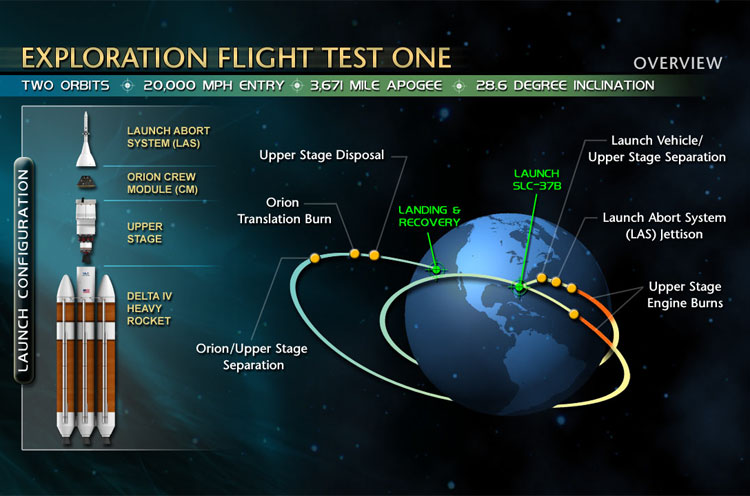
In two years, human space exploration will make its biggest leap in more than four decades.
Lockheed Martin Space Systems will conduct the Orion Exploration Flight Test-1, or EFT-1, in 2014 under contract to NASA. NASA is acquiring the EFT-1 test data for Orion design and development. Lockheed Martin is responsible for performing the flight test and supplying the test data to NASA. The test will launch NASA's Orion spacecraft, without a crew, to an altitude that has not been achieved by a craft intended for human flight since the Apollo lunar landing missions. The milestone test moved closer with the recent selection by Lockheed Martin of the Delta IV Heavy, operated by United Launch Alliance, to launch Orion on the flight.
"We can test parachutes by dropping them from a plane. We can test thrusters in stands on the ground. We can check the splashdown in a water tank. We can test all the pieces and parts, but a space flight is the only place we can see all of these things work together and work under the real conditions they will face with a crew onboard," Orion Program Manager Mark Geyer said.
The EFT-1 flight will take Orion to an altitude of more than 3,600 miles, more than 15 times farther away from Earth than the International Space Station. Orion will return home at a speed almost 5,000 miles per hour faster than any current human spacecraft. It will test the kind of return that will be required when astronauts come home from voyages beyond low Earth orbit. As Orion reenters the atmosphere, it will endure temperatures almost 2,000 degrees F., higher than any human spacecraft since astronauts returned from the Moon.
"This flight test is a challenge. It will be difficult. We have a lot of confidence in our design, but we are certain that we will find out things we do not know," Geyer said. "Having the opportunity to do that early in our development is invaluable, because it will allow us to make adjustments now and address them much more efficiently than if we find changes are needed later. Our measure of success for this test will be in how we apply all of those lessons as we move forward."
The EFT-1 test and the development of Orion are a nationwide effort. In New Orleans, at NASA's Michoud Assembly Facility, the initial construction of the Orion spacecraft for EFT-1 is nearing completion. In Florida, at NASA's Kennedy Space Center, teams are readying to receive the spacecraft when it is shipped there in May to begin final assembly and launch preparations.
In Denver, at the Lockheed Martin facility, a full-scale Orion spacecraft test article recently completed acoustic, modal and vibration testing. In Huntsville, Alabama, NASA's Space Launch System team is developing and building a spacecraft adapter, or interface ring that will be tested during EFT-1 and then used during future SLS flights. In Houston, personnel have begun preparing Mission Control for controlling and monitoring the spacecraft throughout the test flight.
In space, the EFT-1 test will serve as a vital check of the majority of Orion’s systems. But on the ground, it also will provide experience and testing that could be gained nowhere else in the construction, assembly, launch preparations and landing operations for Orion.
"There are people coast to coast building and developing Orion. Just as this test will check how it all works together in space, it already has pulled that team together on the ground," Geyer said. "Their diligence, dedication and focus have been tremendous. They have truly excelled, and when the vehicle for this flight moves to the launch site this summer, they will enter the final lap toward this test."
The first integrated flight test, which follows EFT-1, will be an uncrewed Orion that will be launched on the SLS and is set for 2017. That test will put the entire, integrated exploration system that will return humans to deep space travel through its paces. Orion ultimately will carry astronauts to the moon, asteroids or Mars and other deep space destinations.
Info+Fotos: NASA



6236 Views
